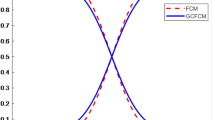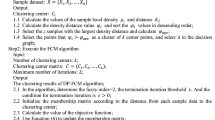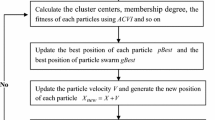Abstract
Fuzzy c-means clustering algorithm (FCM), as the most widely used clustering algorithm, works by iteratively updating the membership degree and the cluster centers to improve the effectiveness of clustering. The performance of FCM algorithm is chiefly evaluated by intra-cluster compactness and inter-cluster separation. However, it has some defects such as high dependency on the initial cluster centers, sensitivity to the noise samples and outliers, difficulties in obtaining the optimization of hyperparameters, a fairly poor performance on datasets with the nonuniform distribution. The main purpose of this paper is to tackle these issues. The novelty of this paper is three-fold: 1) a new FCM clustering algorithm (i.e., CWAFCM) has been proposed, which has a good capability of performing the clustering on datasets with nonuniform distribution and reducing the high dependency on the initial cluster centers; 2) considering the merits of AFCM-SP in removing noise samples and CWAFCM in performing clustering on datasets with nonuniform distribution, a combination of the objective functions of these two clustering algorithms is developed to construct the hybrid AFCM algorithm; and 3) during the parameter setting by means of the PSO algorithm with time-varying acceleration coefficients (PSO-TVAC), a new index, namely adaptive clustering validity index (ACVI), is presented to describe the intra-cluster compactness and the inter-cluster separation in a proper manner. Experiments on six data sets in UCI and one artificial data set have been carried out with a comparison of five well-known FCM algorithms. Experimental results have demonstrated that the proposed hybrid AFCM with adaptive weights can more effectively enhance the performance of FCM to increase the clustering effectiveness than the contrastive algorithms. The ranks for seven algorithms on seven datasets in terms of CVIXB, accuracy, and normalized mutual information(NMI), further verifying the superiority of the new algorithm. Therefore it can be concluded that the proposed hybrid AFCM algorithm performs well in reducing the reliance on the initial cluster centers and the sensitivity to the noise and outliers.



Similar content being viewed by others
Explore related subjects
Discover the latest articles, news and stories from top researchers in related subjects.References
Dunn JC (1973) A fuzzy relative of the ISODATA process and its use in detecting compact Well-Separated clusters. J Cybern 3(3):32–57
Bezdek JC. (1981) Pattern recognition with fuzzy objective function algorithms. Plenum Press
Kesemen O (2016) Fuzzy c-means clustering algorithm for directional data (FCM4DD). Pergamon Press Inc
Goktepe AB, Altun S (2005) Sezer, A.Soil clustering by fuzzy c-means algorithm. Adv Eng Softw 36(10):691–698
Lei Z, Wang L, Wang X, Liu K, Abraham A (2012) Research of neural network classifier based on FCM and PSO for breast cancer classification. Hybrid Artif Intell Syst 7206:647–654
Kari T, Wensheng G (2017) Power transformer fault diagnosis using FCM and improved PCA. J Eng 2017(14):2605–2608
Chen R, Fengbin Z, Liang X (2019) Anomaly Detection Algorithm Based on FCM with improved Krill Herd. J Phys Conf 1187(4):042028
Huang H, Fanzhi M, Shaohua Z, Feng J, Gunasekaran M (2019) Brain image segmentation based on FCM clustering algorithm and rough set. IEEE Access 7:12386–12396
Yang J, Yun-Sheng KE, Mao Zheng W (2017) An adaptive clustering segmentation algorithm based on FCM. Turkish J Electric Eng Comput Sci 25(6):4533–4544
Kannan SR, Devi R, Ramathilagam S, Takezawa K, Effective FCM (2013) Noise clustering algorithms in medical images. Comput Biol Med 43(2):73–83
Qamar U (2014) A dissimilarity measure based Fuzzy c-means (FCM) clustering algorithm. J Intell Fuzzy Syst 26(1):229–238
Ayan S, Karlekar A, Krejcar O et al (2020) Fuzzy c-means clustering using Jeffreys-divergence based similarity measure. Appl Soft Comput 88
Minxuan L (2019) An improved FCM clustering algorithm based on cosine similarity. ACM International Conference Proceeding Series, Hong Kong, pp 103–109
Kumar N, Kumar H, Sharma K (2020) Extension of FCM by introducing new distance metric. SN Applied Sciences 714(2)
Bezdek JC (1974) Numerical taxonomy with fuzzy sets. J Math Biol 1(1):57–71
Bezdek James C (1974) Cluster validity with fuzzy sets. J Cybern 3(3):58–73
Xie XL, Beni G (1991) A validity measure for fuzzy clustering. IEEE Trans Pami 13(8):841–847
Bensaid AM, Hall LO, Bezdek JC, et al. (1996) Validity-guided (re)clustering with applications to image segmentation. IEEE Trans Fuzzy Syst 4(2):112–123
Kwon SH (1998) Cluster validity index for fuzzy clustering. Electronics Letters
Tang Y, Fuchun S, Zengqi S (2005) Improved validation index for fuzzy clustering american control conference
Zhu LF, Wang JS, Wang HY (2019) A novel clustering validity function of FCM clustering algorithm. IEEE Access 7:152289–152315
Lancichinetti A, Fortunato S, Kertész J (2009) Detecting the overlapping and hierarchical community structure in complex networks. New J Phys 11
Munusamy S, Punniyamoorthy M (2020) Modified dynamic fuzzy c-means clustering algorithm application in dynamic customer segmentation. Appl Intell. https://doi.org/10.1007/s10489-019-01626-x
Yang F, Tieli S, Changhai Z (2009) An efficient hybrid data clustering method based on K-harmonic means and particle swarm optimization. Expert Syst Appl 36(6):9847–9852
Hesam I, Ajith A (2011) Fuzzy C-means and fuzzy swarm for fuzzy clustering problem. Expert Syst Appl 38(3):1835–1838
Wu Z, Zhongcheng W, Jun Z (2017) An improved FCM algorithm with adaptive weights based on SA-PSO. Neural Comput Appl (28):3113-3118,2213
Kennedy J, Eberhart R (1995) Particle swarm optimization. Icnn95-international Conference on Neural Networks
Liu W, Zidong W, Xiaohui L, Nianyin Z, David B (2019) A novel particle swarm optimization approach for patient clustering from emergency departments. IEEE Trans Evol Comput 23(04):632–644
Ratnaweera A, Halgamuge SK, Watson HC (2004) Self-organizing hierarchical particle swarm optimizer with time-varying acceleration coefficients. IEEE Trans Evol Comput 8(3):240–255
Zhou KL, Fu C, Yang SL (2014) Fuzziness parameter selection in fuzzy c-means: The perspective of cluster validation. Sci China Inform Sci 57(11):1–8
Acknowledgements
The authors thank the editor and anonymous reviewers for their detailed and constructive comments that help us to increase the quality of this work. This work was supported in part by the National Natural Science Foundation of China under Grant 61873169, in part by the Natural Science Foundation of Shanghai under Grant 18ZR1427100 and in part by the National Natural Science Foundation of China under Grants 62073223.
Author information
Authors and Affiliations
Corresponding author
Ethics declarations
Conflict of Interests
We declare that no conflict of interest exits in the submission of this manuscript, and the manuscript is approved by all authors for publication.
Additional information
Publisher’s note
Springer Nature remains neutral with regard to jurisdictional claims in published maps and institutional affiliations.
Rights and permissions
About this article
Cite this article
Hu, J., Yin, H., Wei, G. et al. An improved FCM clustering algorithm with adaptive weights based on PSO-TVAC algorithm. Appl Intell 52, 9521–9536 (2022). https://doi.org/10.1007/s10489-021-02801-9
Accepted:
Published:
Issue Date:
DOI: https://doi.org/10.1007/s10489-021-02801-9




